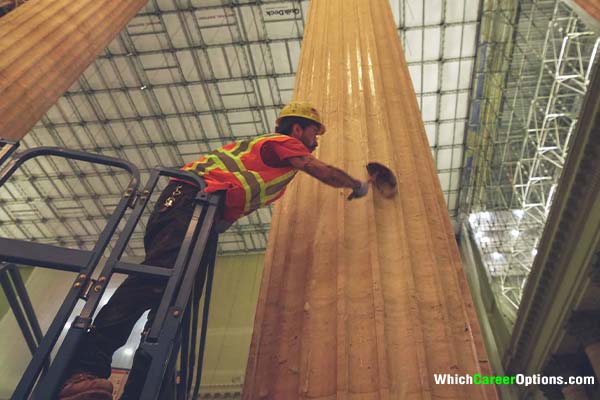What Does a Preservation Architect Do? A Complete Career Guide
Discover what a Preservation Architect does, including key responsibilities, required skills, salary expectations, and career outlook in historic preservation.

Have you ever walked through a beautifully restored historic building and wondered who was responsible for maintaining its original charm while making it functional for modern use? That’s the work of a Preservation Architect—a specialized professional who blends architectural expertise with historical conservation.
If your career quiz results indicate an interest in history, design, and sustainability, this could be the perfect career path for you. This guide will help you understand the role of a Preservation Architect, the skills needed, career progression, and whether this profession aligns with your strengths.
What is a Preservation Architect?
A Preservation Architect is a licensed architect who specializes in the restoration, renovation, and adaptive reuse of historic buildings. Unlike traditional architects who focus on new construction, preservation architects work to protect and revitalize existing structures while respecting their historical significance.
This career is ideal for those who appreciate architectural history, enjoy problem-solving, and want to contribute to cultural heritage conservation.
Key Responsibilities of a Preservation Architect
1. Historical Research & Documentation
- Conduct archival research to understand a building’s original design and materials.
- Document existing conditions through sketches, photographs, and 3D scans.
- Assess structural integrity and identify deterioration causes.
2. Restoration & Adaptive Reuse Planning
- Develop restoration plans that comply with historic preservation standards.
- Design modifications to make old buildings functional for modern use (e.g., adding HVAC systems while preserving original features).
- Select appropriate materials and techniques that match historical authenticity.
3. Compliance & Advocacy
- Ensure projects meet local, state, and federal preservation guidelines (e.g., National Park Service Standards).
- Work with preservation boards and community stakeholders to gain approvals.
- Advocate for the protection of historic sites.
How to Know If a Preservation Architect Is Right for You
Your career quiz may suggest this role if you:
✅ Have a passion for history and architecture.
✅ Enjoy hands-on problem-solving and detailed research.
✅ Are patient and meticulous (restoration projects can take years).
✅ Want a career that combines creativity with technical skills.
If you love the idea of bringing old buildings back to life while preserving their stories, this could be your calling!
Skills & Qualifications Needed for a Preservation Architect
Education & Certifications
- Bachelor’s or Master’s in Architecture (NAAB-accredited program).
- Specialized Training: Courses in historic preservation (e.g., University of Pennsylvania’s Program).
- Licensure: Must pass the Architect Registration Examination (ARE) (NCARB).
- Optional Certifications:
- LEED AP BD+C (for sustainable restoration) (USGBC).
- AIA Historic Preservation Certificate.
Essential Skills
✔ Knowledge of historical construction methods and materials.
✔ Proficiency in AutoCAD, Revit, and photogrammetry software.
✔ Strong project management and communication skills.
✔ Attention to detail and ability to work with preservation laws.
Typical Career Path for a Preservation Architect
| Career Stage | Role & Responsibilities |
|---|---|
| Entry-Level | Preservation Intern/Junior Architect – Assists in research and documentation. |
| Mid-Level | Project Architect – Leads restoration projects and client consultations. |
| Senior-Level | Senior Preservation Architect – Oversees large-scale preservation initiatives. |
| Executive | Principal Architect/Heritage Consultant – Advises on policy and high-profile projects. |
Salary Range & Job Outlook for a Preservation Architect
- Average Salary (U.S.): $60,000 – $100,000+ per year (U.S. Bureau of Labor Statistics).
- Job Outlook: Growing demand due to increased interest in sustainable reuse of historic buildings.
- Trends: Governments and private sectors are investing more in heritage conservation.
Key Terms & Definitions for Preservation Architects
- Adaptive Reuse: Modifying an old building for a new purpose (e.g., turning a factory into lofts).
- Historic District: A protected area with significant architectural heritage.
- Façade Preservation: Restoring only the exterior of a historic building.
Tips for Pursuing a Career as a Preservation Architect
🔹 Gain Hands-On Experience: Volunteer with local preservation societies.
🔹 Build a Portfolio: Showcase restoration projects and research work.
🔹 Network: Join organizations like the National Trust for Historic Preservation.
🔹 Stay Updated: Follow trends in sustainable restoration techniques.
FAQs About Preservation Architects
1. How do I become a Preservation Architect?
Earn an architecture degree, gain experience in restoration, and obtain licensure. Specialized training in historic preservation is highly recommended.
2. Is this career financially stable?
Yes, especially in cities with strong heritage conservation programs. Government and nonprofit sectors also offer opportunities.
3. What’s the most challenging part of the job?
Balancing modern functionality with historical authenticity while working within strict regulations.
Limitations of a Preservation Architect Career
⚠ Slow Project Timelines: Restoration can take years due to meticulous requirements.
⚠ Funding Challenges: Preservation projects often depend on grants and donations.
⚠ Limited Locations: Jobs are concentrated in historic cities and regions.
Final Thoughts
A career as a Preservation Architect is perfect for those who love history, architecture, and sustainability. If your quiz results highlight creativity, patience, and a passion for cultural heritage, this could be your ideal path.
Ready to start? Explore preservation programs and get involved in local heritage projects today!
